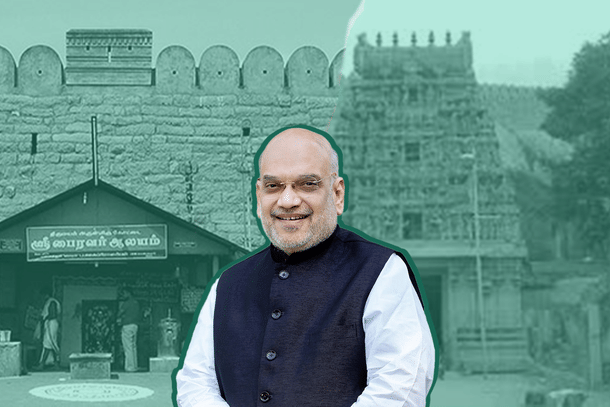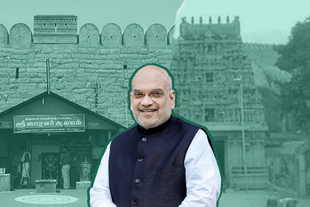Culture
Amit Shah Is Visiting Sathya Giriswarar And Kottai Bhairavar Temples In Tamil Nadu's Thirumayam — Here's What Makes Them Special
S Rajesh
May 30, 2024, 05:57 PM | Updated 05:57 PM IST
Save & read from anywhere!
Bookmark stories for easy access on any device or the Swarajya app.


Union Home Minister Amit Shah is scheduled to visit the Sathya Giriswarar temple and Kottai Bhairavar temples in Puddukkottai district’s Thirumayam this evening (30 May).
The visit comes at a time when Prime Minister Narendra Modi is visiting the Vivekananda Rock Memorial in Kanyakumari to meditate.
Shah was scheduled to visit these temples during his election campaign in the state but his programme was cancelled.
Thirumayam
Thirumayam is a town panchayat and a taluk headquarters located around 20 kilometres south of Pudukkottai, on the way to Karaikudi. ‘Thirumayam’ is derived from ‘Thiru-meyyam’, which means ‘place of truth’ in Tamil. The temples are located in a fort atop a hillock.
The fort was constructed by Vijaya Raghunatha Sethupathi, the ruler of the Ramanathapuram kingdom in 1687.
There is also a Vishnu temple called the Sathya Moorthy Perumal temple nearby. The Shiva and Vishnu temples were built during the Pallava reign and the reason for building them closeby was to reduce disputes between Shaivites and Vaishnavites. People have to cover both temples while doing circumambulation.
Sathya Giriswarar temple
This cave temple was built in the 7th century AD during the reign of the Pallava king Narasimha Varman I.
The lower floor has a number of sub-shrines dedicated to gods like Vinayaka, Durga, Gajalakshmi and Muruga (Karthikeya).
Above this is a mandapam where the shrine of the main goddess, Venuvanesvari is located.
One of the walls in the temple has an inscription recording a settlement regarding the share of the produce of the temple lands to be given to the Shiva and Vishnu temples. It was presided over by a Hoysala general, Appana Dandanayaka. Some of the other inscriptions deal with music.
A level above this is the rock-cut shrine of Sathya-Giriswarar, where there is a lingam, yoni-peetam and a Nandi idol. All of them have been carved out of rock.
Opposite the shrine is a Lingodbhava sculpture which depicts an incident involving Lord Brahma and Lord Vishnu. When the two were discussing which of them were superior, Lord Shiva appeared as an infinite pillar of light and asked them to find the ends. Lord Brahma took the form of a bird and searched for the top end, while Lord Vishnu took the form of a boar.
Kottai Bhairavar Temple
The Kottai Bhairavar temple is located on the northern side of the fort. Bhairavar is a form of Shiva and is considered to be the guardian deity of the fort. Travellers on the route make it a point to stop their vehicles and seek his blessings.
In most Shiva temples, Bhairavar faces the west but here the idol is north facing.
The theipirai ashtami (ashtami day of the waning moon) is an important day of worship for Bhairavar.
(For details about the temples, the author has relied on descriptions provided in a blog dedicated to Pudukkottai’s heritage, a blog titled ‘TN Temples Project’ and Dinamalar.)
S Rajesh is Staff Writer at Swarajya. He tweets @rajesh_srn.





